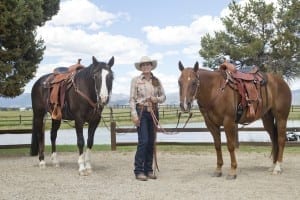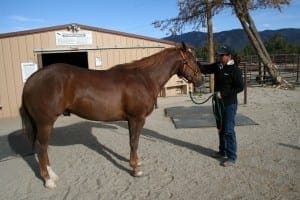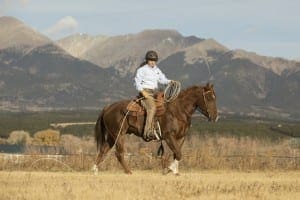
I bought Eddie in the spring of his 3 year old year; he was a handsome and sensible youngster with a great pedigree. A very ‘typey’ stock horse, he stood 14.2 hands and weighed in at about 950; now he is seven years old, 14.3 hands, 1200 pounds and counting. He has matured from a gawky adolescent into a beefcake (think line-backer) —having filled out more than up in the last couple years. And with all these physical changes, he managed to outgrow his saddle this year.

A horse’s body shape changes drastically every year, especially when they are young. If you think about how the human body changes from birth to old age, you know that our bodies change a lot over time as well. But the horse’s body changes three times as fast. If you’ve ever raised foals, you know that it if you sit still and watch long enough, you could practically see them grow.
Growth, stage of life, condition, weight and conformation can all affect saddle fit. What fits your horse today may not work next year, so it is important to analyze your horse’s saddle fit regularly. For the last three years, I’ve ridden Eddie in my favorite ranch saddle, with a regular sized, rigid tree and it fit him well. Until the day it didn’t. Perhaps I was a little slow to notice the subtle changes in his performance as his saddle became uncomfortable, but when the tell-tail white hairs started appearing below his withers, I knew it was time for a change.
Horses are instinctively stoic animals and may work day-in and day-out in discomfort, without much complaint. There may be subtle clues of discomfort in watching the horse work and some horses will let you know if they are uncomfortable, but many will remain silent. Eddie, true to his ranch horse heritage, is very stoic. My other horse, Dually, not so much. If there is so much as a hair out of place, he will be sure to let you know.
For decades I have been traveling around the country and around the globe to help people with their horses. I have often seen horses in my clinics that are hollowed out and inverted (arching their backs and star-gazing instead of rounding) simply because the saddle was causing them discomfort. Lots of things can cause inversion, including the rider, but an ill-fitted saddle can make it downright impossible for a horse to round its back. Adjusting tack, mitigating the fit with pads (when possible) or changing saddles (when it’s not) can often have an immediate and dramatic effect on a horse’s performance.
In Eddie’s case, he had filled out so much (as horses do between 6 and 7), and he had developed heavy muscling over the shoulders and below the withers. Eddie is a classic stock horse type—short, stout and heavily muscled. Sired by Sixes Pick, the world champion ranch horse stallion from the 6666 Ranch, Eddie has taken on the handsome and rugged looks of this classic Quarter Horse. When it comes to tree size, the only part of the horse that matters is from the withers, about 7 inches down; in Eddie’s case, this was the culprit.
The height of the horse or even the width of the horse’s back doesn’t matter much—it’s only what’s going on at the withers, and this is an area that changes a lot over time. Age, fitness and body score (fat deposits) can make a big difference in what the withers looks like. Do not be lulled into thinking that because you have a wide or heavy horse, like a draft or draft cross, that you automatically need a wide tree. Many big horses have prominent, V-shaped withers and need a regular tree. Height and body width aren’t the issue.
There’s lots of confusion on tree sizes in Western saddles, which is one reason why saddle makers are getting away from the baffling terms like ‘Semi quarter horse’ and ‘Full quarter horse bars,’ and instead call them Regular and Wide trees. It matters not at all whether you have a quarter horse, a Haflinger or a gaited horse.
Looking at the front of the saddle, under the pommel at the bars of the tree, the regular tree is generally a 90 degree angle and the wide tree is usually 92 degrees. That’s not a lot of difference to see (or try and measure) but it can make a huge difference in fit. If the saddle tree is too narrow, it will perch on top of the shoulders instead of sitting ‘in the pocket’ behind the shoulders and put undue pressure at the top of the shoulder blade (where white spots often appear). Although a majority of horses, even Quarter Horses, fit in a regular sized tree, some horses will need the extra width. If the tree is too wide, the saddle may sit down too low and there may not be enough clearance at the withers.
When I bought Eddie as a 3 year old, I did not buy a saddle for him, since I already had a tack room full of saddles that I loved. For the past three years, I’ve been using my Rocky Mountain Ranch saddle (a working saddle designed by me and made by Circle Y) with a wooden, Kevlar reinforced, regular size tree, which fit him well. Until the day it didn’t. It’s a beautiful and functional saddle which looked very handsome on my honcho ranch horse.

If I had bought the saddle just for Eddie, I would’ve bought a wide tree, knowing there was a very good chance that he would need it in the future, given his type. When in doubt, it is not a bad idea to go with a wide tree, because if it is a little too big, you can usually pad out the fit. But if your tree is too small, there’s no fixing it. It’d be like wearing a pair of shoes that were too small and then putting on extra thick socks to try and fix the discomfort.
Once it became clear that Eddie had outgrown the regular tree, and I was going to have to buy a new saddle for him, I decided to switch him to the Circle Y Monarch Arena/Trail saddle with a Flex2 tree in a wide size. I designed this saddle for comfort, balance and close-contact communication with your seat and legs. It helps center the rider and has a narrow twist with memory foam in the seat. I’ve been riding my other horse, Dually, in this same saddle (regular tree) since I designed it, nearly a decade ago.
On my very first ride on Eddie in the Monarch, I was astounded at the change and wished I had switched sooner. With the right size tree and the additional comfort that the flexible tree provides, Eddie was immediately more relaxed, lengthening in the neck and lifting his back. Not only that, his rough gaits were significantly smoother, not only because he was relaxing and rounding more but also because the Flex2 tree provides shock absorption that is easily felt by both horse and rider.
I’ll admit, Eddie is definitely more handsome in the ranch saddle, as is befitting of his heritage. But I will trade that for comfort and performance any day of the week. The Monarch is also a beautiful hand-tooled saddle that any horse looks great in and once I am up there, it only matters how it feels—to both my horse and me!
Enjoy the ride,
Julie
Become a Julie Goodnight Library Member